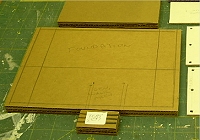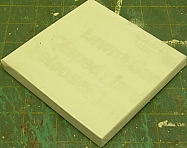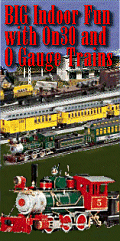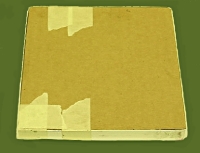
|
||||
| Your source for custom-made, handcrafted Christmas village houses and churches | ||||

| HOME PAGE |
PHOTO GALLERY |
ORDERING DETAILS |
ABOUT THE CRAFTSMAN |
HOUSE KIT |
HOWARD'S HOW-TO'S |
FAVORITE LINKS |
| Written by Howard Lamey (with a little help from Paul Race) for Big Indoor Trains™ and LittleGlitterhouses.com. |
|
|
Building Glitterhouse BasesForming the BaseThe base for a vintage-style cardboard structure is a rectangular "box" that is primed, and sometimes decorated before the house and trees are installed. Howard builds his so that they are lightweight, but solid, with a finish reminiscent of the original cardboard mid-19th-century glitterhouses. The length and width of the base varies with the structure - usually you want to add a few inches to allow room for gates, fences, or hedges to dress up your buildings. The height, on the other hand, is usually at least 1/2". For a very large structure, you may want to make the base even thicker. room for gates, fences, or hedges to dress up your buildings. The height, on the other hand, is usually at least 1/2". For a very large structure, you may want to make the base even thicker.
You may form the box either of two ways:
 
Finishing the BaseAfter the base is built, you then cover it with white bond acid-free paper just like you would wrap a gift, except that all surfaces of the paper cover must be glued down to the box. A glue stick works great for this.When the glue has dried, paint the box with the base coat you have chosen. In most cases this is a flat white latex or acrylic paint. A flat white interior wall paint is nice because it suggests the "chalky" feeling of the paper-mache finish typical of many early glitterhouses. ConclusionHow the base is finished depends on what the rest of the house looks like. If the house is set in a season other than winter, you may want to paint the base with a different colored topcoat before you attach the house and accessories. A Note from the Designer: Now that I'm in "retirement," this hobby has become a sort of avocation for me. Several folks have commissioned me to build specific houses for them. So if you'd like me to "bid" on a cardboard house for you, or if you have any questions at all, please visit our Orders page. - Howard Also, if you have a similar project you'd like to share with your fellow readers and hobbyists, we'd love to add it to our site, and we'll be sure to give you full credit for your contribution. Other Articles about Glitterhouse include:
Other Putz House Resources:
Other Articles that Discuss Putzes and Christmas Villages of the mid-20th Century:
To return to the "Howard's How-To" page, click here. |













